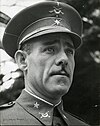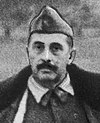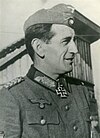Ministry of the Army
| Spanish: Ministerio del Ejército | |
 Palace of Buenavista, formerly the site of the army ministry | |
| Agency overview | |
|---|---|
| Formed | 9 August 1939 |
| Preceding |
|
| Dissolved | 4 July 1977 |
| Superseding agency | |
| Jurisdiction | Spanish Army |
| Headquarters | Palace of Buenavista |
| Ministers responsible |
|
The Ministry of the Army (Spanish: Ministerio del Ejército) was a government department of Spain that was tasked with oversight of the Spanish Army (Ejército de Tierra) during the Francoist regime.
The ministry was created on 8 August 1939, after the end of the Spanish Civil War. It was dissolved on 4 July 1977 by the Royal Decree 1558/77, being merged with the Ministry of Defence as part of the transition to democracy.
History
[edit]The Ministry of the Army originated in the Ministry of War, which existed from the 19th century to the Second Spanish Republic, coinciding with the beginning of the Spanish Civil War and the reorganization of the governmental structure. When the first government of Francisco Franco was formed in 1938, the Ministry of National Defense was established under the then commander of the Army of the North, Fidel Dávila Arrondo.[1] The three branches of the Armed Forces (Army, Navy and Air Force) were grouped under its control.[2] It was disestablished on 8 August 1939, after the end of the Civil War, when the ministries of Army, Navy and Air were created in the second government of Francisco Franco.[2] On 22 September the organic structure of the new ministerial department was organized.[3]
Over the years, the Ministry became a bureaucratic giant,[4] practically closed to society and the country that were progressively evolving.[5] The Ministry became a slow organism, without even a standardized and unified administrative criterion due to the internal contradictions of its different departments and the multiple competencies that each of them had.[6] The administrative inefficiency reached the point that sometimes the departments of the Ministry encountered problems in coordinating the Military Regions of Spain with each other.[6] Thus, the Ministry became the exponent of a bureaucratic office where it was possible to obtain a position or administrative charges depending on the services provided to the regime,[7] or to the rampant nepotism that prevailed within the Army.[8]
The Ministry was abolished by the Royal Decree 1558/77 of 4 July 1977, when Prime Minister Adolfo Suárez created the Ministry of Defence as part of his second government (formed following the 1977 general election[9]), which integrated the ministries of the Army, Navy and Air Force during the transition to democracy.
Organic structure
[edit]On 22 September 1939 the structure of the Ministry was organized, being composed of the following departments:[3]
- General Staff of the Army
- General Secretariat
- General Directorates: Military Education, Recruitment and Personnel, Industry and Material, Transportation
- General Inspection of Fortifications
- Directorate-General of the Civil Guard and Carabineros
- Superior Council of the Army
- Supreme Council of Military Justice
The new Supreme Council of Military Justice regained functions and powers of the former Supreme Council of War and Navy, disappeared during the Second Republic following the military reforms of Manuel Azaña (Azaña Law).[10] The powers of this tribunal were not limited only to the Army, but also the Navy and the Air Force. In addition, it implied the full restoration of the Code of Military Justice of 1890.
In the case of the Civil Guard, it was subject to the Ministry of the Army "in everything related to its organization, discipline, armament and personnel", but also depended in other areas of the Ministry of the Interior and Ministry of Finance.[11] The Carabineros were integrated into the Civil Guard in 1940 and disappeared, while the new Armed Police Corps, created in 1941, was also subject to the Army in some areas.[12]
List of ministers
[edit]| No. | Portrait | Minister | Took office | Left office | Time in office | Party | Cabinet | Ref. |
|---|---|---|---|---|---|---|---|---|
| 1 | Lieutenant General José Enrique Varela (1891–1951) [a] | 9 August 1939 | 3 September 1942 | 3 years, 25 days | Military | Franco II | [13] | |
| 2 | Lieutenant General Carlos Asensio Cabanillas (1896–1970) | 3 September 1942 | 20 July 1945 | 2 years, 320 days | Military | Franco II | [14] | |
| 3 | Lieutenant General Fidel Dávila Arrondo (1878–1962) | 20 July 1945 | 19 July 1951 | 5 years, 364 days | Military | Franco III | [15] | |
| 4 | Lieutenant General Agustín Muñoz Grandes (1896–1970) | 19 July 1951 | 25 February 1957 | 5 years, 221 days | Military | Franco IV | [16] | |
| 5 | Lieutenant General Antonio Barroso Sánchez-Guerra (1893–1982) | 25 February 1957 | 11 July 1962 | 5 years, 136 days | Military | Franco V | [17] | |
| 6 | Lieutenant General Pablo Martín Alonso (1896–1964) | 11 July 1962 | 11 February 1964 † | 1 year, 215 days | Military | Franco VI | [18] | |
| – | Admiral Pedro Nieto Antúnez (1898–1978) Acting Minister of the Navy | 11 February 1964 | 25 February 1964 | 14 days | Military | Franco VI | [19] | |
| 7 | General Camilo Menéndez Tolosa (1899–1971) | 25 February 1964 | 30 October 1969 | 5 years, 247 days | Military | Franco VI–VII | [20] | |
| 8 | Lieutenant General Juan Castañón de Mena (1903–1982) | 30 October 1969 | 9 June 1973 | 3 years, 222 days | Military | Franco VIII | [21] | |
| 9 | General Francisco Coloma Gallegos (1912–1993) | 12 June 1973 | 12 December 1975 | 2 years, 183 days | Military | Carrero Blanco Arias Navarro I | [22][23] | |
| 10 | Lieutenant General Félix Álvarez-Arenas (1913–1992) | 12 December 1975 | 5 July 1977 | 1 year, 205 days | Military | Arias Navarro II Suárez I | [24][25] |
Notes
[edit]- ^ Dismissed in the aftermath of the Begoña Bombing.
See also
[edit]References
[edit]- ^ Thomas (1976); pág. 811
- ^ a b Mariano Aguilar Olivencia (1999); pág. 38
- ^ a b BOE núm. 274, pág. 5485 (22 de septiembre de 1939)
- ^ Mariano Aguilar Olivencia (1999); pág. 123
- ^ Mariano Aguilar Olivencia (1999); pág. 127
- ^ a b Mariano Aguilar Olivencia (1999); pág. 124
- ^ Mariano Aguilar Olivencia (1999); pág. 56
- ^ Mariano Aguilar Olivencia (1999); pág. 224
- ^ "Suárez, confirmado por el Rey, formará nuevo Gobierno". El País (in Spanish). 18 June 1977. Retrieved 4 January 2020.
- ^ Ballbé, Manuel (1983). Orden público y militarismo en la España constitucional (1812–1983) (in Spanish). Madrid: Alianza Editorial. p. 348.
- ^ Mariano Aguilar Olivencia (1999); pág. 59
- ^ Mariano Aguilar Olivencia (1999); pág. 60
- ^ "Decretos de 9 de agosto de 1939 nombrando Ministros de Asuntos Exteriores a don Juan Beigbeder Atienza; Ejército, Al General de División D. José Enrique Varela Iglesias; Marina, Al Vicealmirante D. Salvador Moreno Fernández: Aire, al General de Brigada, D. Juan Yagüe Blanco: Justicia, a D. Esteban Bilbao Eguía; Hacienda, a don José Larraz López; Industria y Comercio, a don Luis Alarcón de la Lastra; Agricultura, a D. Joaquín Benjumea Burín; Educacion Nacional, a D. José Ibáñez Martín" (PDF). Boletín Oficial del Estado (in Spanish) (223). Agencia Estatal Boletín Oficial del Estado: 4376–4377. 11 August 1939. ISSN 0212-033X.
- ^ "Decreto de 3 de septiembre de 1942 por el que se nombra Ministro del Ejército a don Carlos Asensio Cavanillas" (PDF). Boletín Oficial del Estado (in Spanish) (247). Agencia Estatal Boletín Oficial del Estado: 6799. 4 September 1942. ISSN 0212-033X.
- ^ "Decreto de 20 de julio de 1945 por el que se nombra Ministro del Ejército a don Fidel Dávila Arrondo" (PDF). Boletín Oficial del Estado (in Spanish) (202). Agencia Estatal Boletín Oficial del Estado: 520. 21 July 1945. ISSN 0212-033X.
- ^ "Decreto de 19 de julio de 1951 por el que se nombra Ministro del Ejército a don Agustin Muñoz Grandes" (PDF). Boletín Oficial del Estado (in Spanish) (201). Agencia Estatal Boletín Oficial del Estado: 3447. 20 July 1951. ISSN 0212-033X.
- ^ "Decreto de 25 de febrero de 1957 por el que se nombra Ministro del Ejército a don Antonio Barroso Sánchez-Guerra" (PDF). Boletín Oficial del Estado (in Spanish) (57). Agencia Estatal Boletín Oficial del Estado: 1235. 26 February 1957. ISSN 0212-033X.
- ^ "Decreto 1494/1962, de 10 de julio, por el que se nombra Ministro del Ejército a don Pablo Martín Alonso" (PDF). Boletín Oficial del Estado (in Spanish) (165). Agencia Estatal Boletín Oficial del Estado: 9653. 11 July 1962. ISSN 0212-033X.
- ^ "Decreto 311/1964, de 11 de febrero, por el que se dispone que se encargue del Despacho del Ministerio del Ejército el Ministro de Marina" (PDF). Boletín Oficial del Estado (in Spanish) (37). Agencia Estatal Boletín Oficial del Estado: 1914. 12 February 1964. ISSN 0212-033X.
- ^ "Decreto 360/1964, de 20 de febrero, por el que se nombra Ministro del Ejército a don Camilo Menéndez Tolosa" (PDF). Boletín Oficial del Estado (in Spanish) (45). Agencia Estatal Boletín Oficial del Estado: 2342. 21 February 1964. ISSN 0212-033X.
- ^ "Decreto 2554/1969, de 29 de octubre, por el que se nombra Ministro del Ejército a don Juan Castañón de Mena" (PDF). Boletín Oficial del Estado (in Spanish) (260). Agencia Estatal Boletín Oficial del Estado: 16977. 30 October 1969. ISSN 0212-033X.
- ^ "Decreto 1159/1973, de 11 de junio, por el que se nombran los Ministros del Gobierno" (PDF). Boletín Oficial del Estado (in Spanish) (140). Agencia Estatal Boletín Oficial del Estado: 11883. 12 June 1973. ISSN 0212-033X.
- ^ "Real Decreto 1607/1976, de 7 de julio, por el que que se nombran los Ministros del Gobierno" (PDF). Boletín Oficial del Estado (in Spanish) (163). Agencia Estatal Boletín Oficial del Estado: 13385. 8 July 1976. ISSN 0212-033X.
Bibliography
[edit]- Aguilar, Mariano (1999). El ejército español durante el franquismo (in Spanish). Madrid: Ediciones Akal. ISBN 84-460-0962-5.
- Tamames Gómez, Ramón (1974). Historia de España Alfaguara VII. La República. La Era de Franco (in Spanish). Madrid: Alianza Editorial.
- Hugh, Thomas (1976). La Guerra Civil Española (in Spanish). Barcelona: Grijalbo. ISBN 84-253-2767-9.






